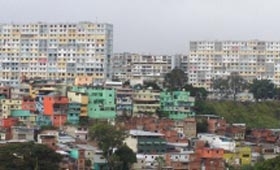Venezuela saw its most deadly year ever in 2011, according to a new report, thanks to the spread of urban militias and the rise of violent street crime, while confrontational political rhetoric may also play a part.
In a report that uses data from the police and various civil society organizations, the Metropolitan Observatory on Citizen Security (OMSC) says that Venezuela saw nearly 19,000 murders in 2011. This would put Venezuela’s murder rate at 66 per 100,000, up from 48 in 2010.
This makes it one of the most dangerous places in the world, surpassed only by Honduras and El Salvador. But in Venezuela, the causes of skyrocketing violence are more difficult to identify. It does not have the maras of El Salvador or political crisis of Honduras, nor does it suffer from an armed conflict like neighboring Colombia.
But Venezuela is growing ever more violent. As the OMSC points out, the murder rate almost tripled between 1998 and 2009, while last year’s shot up a third from 2010.
Some clues as to the causes of this rising violence can be found in the OMSC report. A disproportionate number of the killings last year took place in Caracas, giving it a murder rate of 108 per 100,000, up from 71 the previous year. The most violent part of the capital was the municipality of Libertador, where murders surged 64 percent from 2010, to reach a rate of 133 per 100,000.
In a press conference announcing the launch of the report, the OMSC’s Fermin Marmol described Enero 23, one of the neighborhoods that makes up Libertador, as a “micro-state” outside the government’s control, saying that such areas were a factor feeding insecurity in the country. He said that the neighborhood was controlled by some 300 armed men, and that police could not enter there without the consent of these “paramilitaries.” Enero 23 is one of the main sites of urban “colectivo” groups, armed forces which are tolerated and at times encouraged by the government, and which sometimes carry out attacks on the opposition. International Crisis Group said in a report last year that eight of Caracas’ 12 colectivos are based in Enero 23. It also cites reports that these organizations may have up to 2,000 armed members in total.
An example of the violence generated by these groups was given this weekend, when clashes broke out in Enero 23. There were riots, and cars and motorbikes burnt. El Universal reported that the disturbances were due to local colectivo La Piedrita carrying out revenge attacks after the killing of two of their members.
A large part of Venezuela’s rising violence is made up by street crime, however, as well as these kind of gang clashes, with the report noting that around a quarter of murders in Caracas are linked to robberies. A further 6 percent are due to stray bullets hitting bystanders, an indication of how dangerous and chaotic the environment can be. Almost three-quarters of murder victims in the city were men aged 15 to 44.
The report also says that 90 percent of murders in the capital were carried out with a firearm, pointing to the wide availability of guns as a factor in the high number of homicides. Of those killed by firearms, 80 percent had multiple bullet wounds, giving an indication of the ferocity of attacks. Thirty percent, meanwhile, suffered more than six wounds. As InSight Crime said when the murder figures were first released in January, one factor in the wide availability of firearms is the government’s distribution of guns to volunteer militias, with little oversight about whether volunteers use their guns while off duty, or allow them to leak into the black market. A Small Arms Survey report estimated that there were up to 4.1 million civilian firearms in the country.
The international drug trade is another driver of murders in Venezuela. The country is now thought to be the main transit country for Colombian cocaine, with some 200 tons of the drug passing through the country each year. As InSight Crime has observed, the large quantities of drugs moving through Venezuela have helped stimulate the growth of criminal groups, encouraging other crimes like murder, kidnapping, and extortion, as well as local drug consumption. The trade breeds corruption in state bodies; even as the amount of cocaine in Venezuela has risen, the amount seized by the government has dropped. The latest State Department report notes claims that elements of Venezuela’s security forces “directly assisted” operations by groups like the Revolutionary Armed Forces of Colombia (FARC) and Sinaloa Cartel to traffic drugs through the country.
However, another factor that may be just as important as the drug trade or the presence of firearms is the culture of violence, stoked by divisive policies and rhetoric as part of Chavez’s “Bolivarian Revolution.” In its end-of-year report for 2011, the Venezuelan Observatory on Violence (OVV) likened the conditions to that of a war zone, saying that, although the country has not been at war, violence has become legitimized as a way of resolving disagreements, with little respect for life. “In Venezuela, these effects have taken place without having had a war, due to the continual praise of violence and of violent people, due to the growing impunity in the country and the continuous calls for war.” International Crisis Group also highlighted President Hugo Chavez’s “confrontational rhetoric” as being a contributor to the entrenchment of violence in Venezuelan society.
It is difficult to quantify just how much of the violence has to do with crime and street gangs, and how much could be described as political. But as the report illustrates, the various factors driving citizen security problems seem to be multiplying, not growing smaller. That should raise an alarm bell for whatever government inherits the country come October’s presidential elections.

